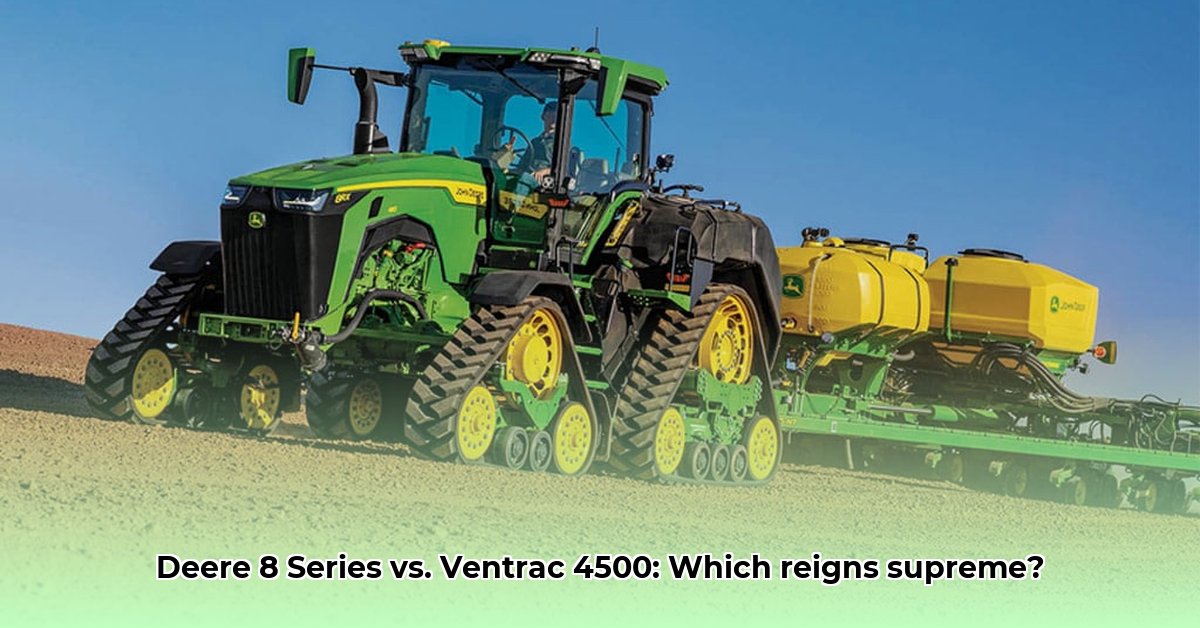
Deere 8 Series: Precision Power for Sustainable Large-Scale Farming
The John Deere 8 Series, often configured as an 8-wheel tractor, represents a high-horsepower approach to sustainable agriculture. Its strength lies in precision technology. GPS guidance, yield monitoring, and variable-rate application (VRA) systems optimize resource use. This minimizes fertilizer and pesticide waste, directly contributing to environmental protection and cost savings. For example, VRA can reduce herbicide application by up to 20%, leading to significant cost savings and environmental benefits. However, the initial investment and ongoing operating costs (higher fuel consumption, for instance) are substantial, making this model best suited for large-scale operations with extensive, uniform fields. The higher fuel consumption raises a crucial question: does the precision technology's environmental benefits outweigh the increased fuel usage? Learn more about John Deere's largest tractors at John Deere's biggest.
Ventrac 4500: Adaptable Sustainability for Diverse Small Farms
In contrast, the Ventrac 4500, while now discontinued, highlights a different path to sustainable farming. Its compact size and extensive array of attachments offer unmatched versatility. This adaptability allows for a wide range of applications, potentially replacing multiple specialized machines on smaller farms. This reduction in equipment translates to lower purchasing and maintenance costs and reduces the overall environmental footprint. The Ventrac’s smaller engine also results in lower fuel consumption per task, making it a cost-effective and environmentally sound choice for diversified small farms. But can its relatively low horsepower handle the demands of large-scale operations or heavy-duty tasks?
Comparative Analysis: Deere 8 Series vs. Ventrac 4500
The following table directly compares the two tractors' sustainability features:
| Feature | John Deere 8 Series | Ventrac 4500 |
|---|---|---|
| Size | Large | Compact |
| Horsepower | Very High | Relatively Low |
| Versatility | High (through specialized add-ons) | Extremely High (wide range of attachments) |
| Ideal Farm Size | Large, single-crop farms | Small to medium, diverse crops |
| Sustainability Focus | Precise resource use, maximizing yields | Reduced equipment, lower fuel use |
| Initial Cost | High | Lower |
| Fuel Efficiency (per task) | Potentially lower (higher power demand) | Potentially higher (smaller scale operations) |
Important Note: A comprehensive lifecycle assessment (LCA) comparing the total environmental impact (including manufacturing, operation, and disposal) of both tractors is currently lacking. Further research is needed to quantify long-term sustainability metrics accurately for a definitive comparison.
Sustainability Implications: A Broader Perspective
The choice between these tractors reflects a broader commitment to sustainable agricultural practices. Fuel consumption is a key factor, but equally important are the tractor's lifespan, the ease of repairs, and the sourcing and disposal of its components. A longer-lasting, easily repairable machine has an inherently lower environmental impact than one frequently replaced. Government policies also play a crucial role, providing incentives for adopting sustainable technologies and practices. For instance, tax breaks for purchasing fuel-efficient tractors could significantly accelerate the adoption of more sustainable equipment.
Actionable Recommendations for Stakeholders
- Farmers (Large-Scale): Invest in precision technology (GPS, VRA) to optimize resource use. Explore alternative fuels (biodiesel) to reduce reliance on fossil fuels.
- Farmers (Small-Scale): Consider the versatility of compact tractors and explore equipment-sharing initiatives with neighbors to further reduce costs and environmental impact.
- Tractor Manufacturers: Prioritize the use of sustainable materials in tractor construction and develop tractors with more efficient engines and alternative fuel capabilities.
- Policymakers: Implement financial incentives (tax breaks, subsidies) to encourage the adoption of sustainable agricultural equipment and practices. Fund research into the long-term sustainability of farm machinery.
Conclusion: Choosing the Right Tractor for a Sustainable Future
The choice of agricultural machinery is paramount to achieving a truly sustainable future for farming. The Deere 8 Series and the Ventrac 4500 represent contrasting, yet equally valid, approaches, each best suited to different farm sizes and operational needs. The lack of comprehensive lifecycle assessment data highlights a critical need for further research to guide future purchasing decisions and inform policy interventions. The ongoing pursuit of innovation and environmentally responsible practices will shape the future of agriculture.